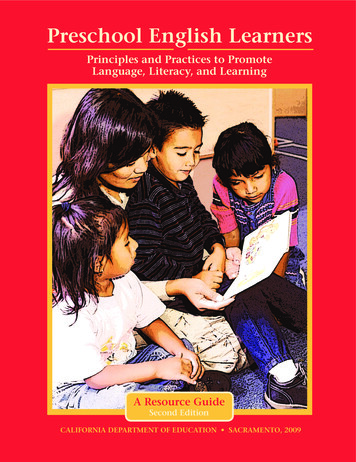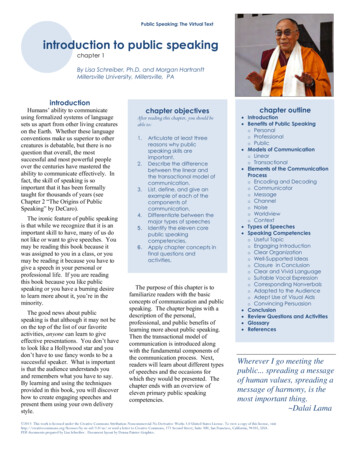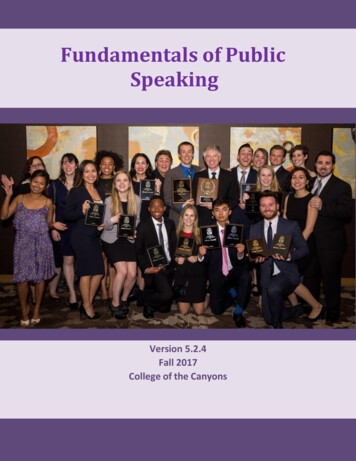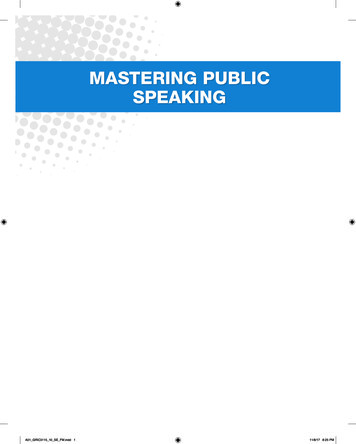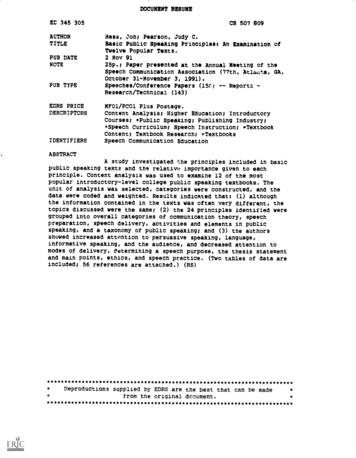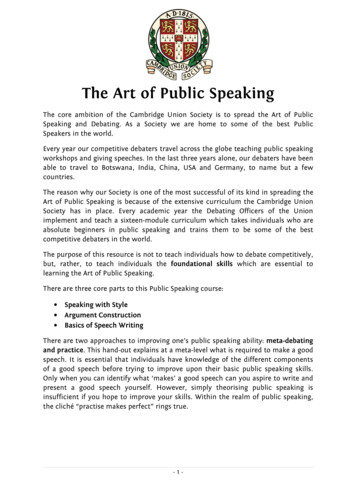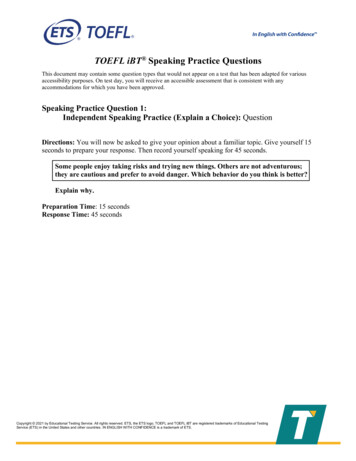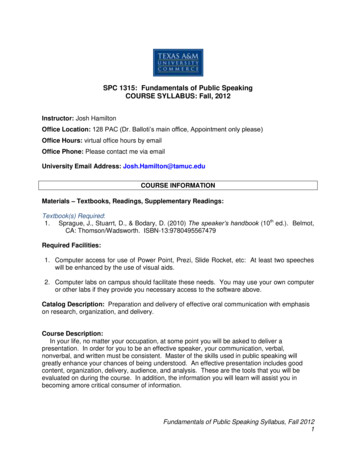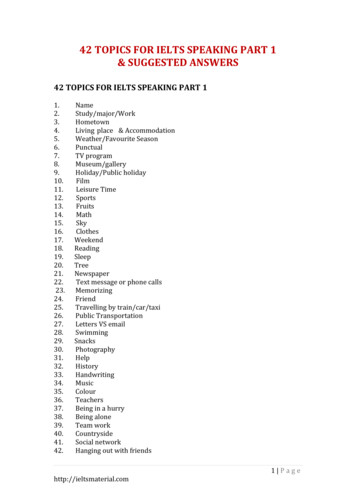
Transcription
A BRIEF CONTENTSPART 1 GETTING STARTED11. Becoming a Public Speaker22. From A to Z: Overview of a Speech83. Managing Speech Anxiety144. Ethical Public Speaking235. Listeners and Speakers30PART 2 DEVELOPMENT366. Analyzing the Audience377. Selecting a Topic and Purpose498. Developing Supporting Material579. Locating Supporting Material6410. Doing Effective Internet Research7311. Citing Sources in Your Speech83PART 3 ORGANIZATION9212. Organizing the Speech9313. Selecting an Organizational Pattern10314. Outlining the Speech110PART 4 STARTING, FINISHING,AND STYLING12215. Developing the Introduction and Conclusion12316. Using Language131PART 5 DELIVERY13917. Choosing a Method of Delivery14018. Controlling the Voice14419. Using the Body148
PART 6 PRESENTATION AIDS15420. Types of Presentation Aids15521. Designing Presentation Aids16122. A Brief Guide to Microsoft PowerPoint164PART 7 TYPES OF SPEECHES17423. Informative Speaking17524. Persuasive Speaking18825. Speaking on Special Occasions217PART 8 THE CLASSROOM AND BEYOND 23026. Typical Classroom Presentation Formats23127. Science and Mathematics Courses23628. Technical Courses24029. Social Science Courses24330. Arts and Humanities Courses24631. Education Courses24832. Nursing and Allied Health Courses25133. Business Courses and Business Presentations25334. Presenting in Teams25835. Communicating in Groups262APPENDICES267A. Citation Guidelines268B. Question-and-Answer Sessions282C. Preparing for Mediated Communication284D. Tips for Non-Native Speakers of English286Glossary290Notes309Index323
This page intentionally left blank
CONTENTSPART 1 GETTING STARTED11. BECOMING A PUBLIC SPEAKERA Vital Life SkillSpeech as CommunicationClassical Roots22. SPEECH OVERVIEWTopic SelectionAudience AnalysisSpeech PurposeThesis StatementMain PointsSupporting MaterialsMajor Speech PartsOutlinePresentation AidsDelivery83. SPEECH ANXIETYCauses of AnxietyOnset of AnxietyBoosting ConfidenceRelaxation TechniquesUsing MovementLearning from Feedback144. ETHICSAudience TrustAudience ValuesFree Speech and ResponsibilityPositive Public DiscourseEthical Ground RulesAvoiding Offensive SpeechAvoiding PlagiarismFair Use, Copyright, and EthicsAvoiding Internet Plagiarism235. LISTENINGSelective ListeningResponsible ListeningExchanging IdeasListening ObstaclesActive ListeningEvaluating EvidenceFeedback30PART 2 DEVELOPMENT366. AUDIENCE ANALYSISPsychologyDemographicsCultural DifferencesSeeking InformationSetting and Context377. TOPIC AND PURPOSE49Where to BeginConsider the AudienceAvoid Overused TopicsGeneral PurposeNarrowed TopicSpecific PurposeThesis Statement From Source to Speech: NarrowingYour Topic Online8. DEVELOPING SUPPORTExamplesStories57TestimonyFacts and StatisticsAccurate StatisticsEthical StatisticsOral References9. LOCATING SUPPORT64Secondary Sources From Source to Speech: Citing Books From Source to Speech: CitingPeriodicalsEvaluating SourcesRecording References10. INTERNET RESEARCH73Using a Library PortalBeing a Critical ConsumerInformation, Propaganda,Misinformation, and DisinformationInternet Search Tools From Source to Speech: EvaluatingWeb SitesCommercial Factors From Source to Speech: Citing WebSitesSmart SearchesRecording Sources11. CITING SOURCES83Conveying Source Information From Source to Speech:Demonstrating Source CredibilitySample Oral CitationsCiting Facts and StatisticsCiting Summaries and ParaphrasesPART 3 ORGANIZATION9212. ORGANIZING THE SPEECHMain PointsSupporting PointsOrganizationTransitions From Point to Point: UsingTransitions9313. ORGANIZATIONAL PATTERNS 103ChronologicalSpatialCausal ular14. OUTLINING THE SPEECHCreate Two OutlinesOutline FormatsWorking OutlinesSpeaking OutlinesPracticing110PART 4 STARTING, FINISHING,AND STYLING12215. INTRODUCTIONS ANDCONCLUSIONS12316. LANGUAGE131Writing for the EarConcrete Words, Vivid Imagery
Building CredibilityCreating an ImpressionPART 5 DELIVERY17. METHODS OF DELIVERY13914018. THE VOICE144VolumeIntonationRatePausesVocal VarietyPronounciation and ArticulationDialect19. THE BODYBody LanguagePracticing Delivery148PART 6 PRESENTATION AIDS 15420. TYPES OF PRESENTATIONAIDSAppropriate AidsDisplaying AidsRehearsing21. DESIGNING PRESENTATIONAIDSSimplicityConsistencyTypefaces and FontsColorInterpretations of Color22. GUIDE TO POWERPOINTA Speech, Not a Slide ShowDevelop Effective SlidesAvoid Technical GlitchesUsing PowerPoint155161164PART 7 TYPES OF SPEECHES 17423. INFORMATIVE175Fostering Audience InvolvementInformative Topic AreasPresenting InformationReducing ConfusionArranging Main PointsSample Informative SpeechJohn Kanzius and the Quest toCure Cancer, David Kruckenberg24. PERSUASIVE188MotivationReason and EmotionCredibilityListener NeedsMental EngagementArgumentsCultureOrganizationSample Persuasive SpeechesEmergency in the Emergency Room,Lisa RothThe Importance of CommunityEngagement and Volunteerism,Stephanie Poplin25. SPECIAL OCCASION217Speeches of IntroductionSpeeches of AcceptanceSpeeches of PresentationRoasts and ToastsEulogies and Other TributesAfter-Dinner SpeechesSpeeches of InspirationSample Special Occasion SpeechesBest Man Wedding Toast, BenPlatt2004 University of PennsylvaniaCommencement Address, BonoPART 8 THE CLASSROOMAND BEYOND23026. TYPICAL CLASSROOMFORMATS231Review of Academic ArticlesTeam PresentationsDebatesPoster SessionsPreparing for Different Audiences27. SCIENCE AND MATHEMATICSCOURSES23628. TECHNICAL COURSES24029. SOCIAL SCIENCE COURSES24330. ARTS AND HUMANITIESCOURSES24631. EDUCATION COURSES24832. NURSING AND ALLIED HEALTHCOURSES25133. BUSINESS COURSES25334. PRESENTING IN TEAMS25835. COMMUNICATING IN GROUPS 262APPENDICESA. Citation Guidelines: Chicago,APA, MLA, CSE, IEEEB. Question-and-Answer SessionsC. Preparing for MediatedCommunicationD. Tips for Non-Native Speakersof EnglishGlossaryNotesIndex267268282284286290309323
A PocketGuide toPublicSpeakingTHIRD EDITIONGetting Started Development Starting, Finishing, and StylingPresentation Aids Organization DeliveryTypes of SpeechesClassroom and Beyond TheCitation GuidelinesDan O’HairUniversity of OklahomaHannah RubensteinRob StewartTexas Tech UniversityBedford / St. Martin’sBoston New York
For Bedford/St. Martin’sExecutive Editor for Communication: Erika GutierrezExecutive Developmental Editor: Simon GlickDevelopmental Editor: Lai T. MoyEditorial Assistant: Mae KlingerProduction Editor: Bill ImbornoniProduction Supervisor: Andrew EnsorMarketing Manager: Adrienne PetsickArt Director: Lucy KrikorianText Design: Claire Seng-NiemoellerCopy Editor: Hilly van LoonIndexer: Leoni Z. McVeyCover Design: Donna L. DennisonComposition: Macmillan Publishing SolutionsPrinting and Binding: Quebecor World Eusey PressPresident: Joan E. FeinbergEditorial Director: Denise B. WydraDirector of Development: Erica T. AppelDirector of Marketing: Karen R. SoeltzDirector of Editing, Design, and Production: Marcia CohenAssistant Director of Editing, Design, and Production: Elise S. KaiserManaging Editor: Shuli TraubLibrary of Congress Control Number: 2009933859Copyright 2010, 2007, 2004 by Bedford/St. Martin’sAll rights reserved. No part of this book may be reproduced,stored in a retrieval system, or transmitted in any form or by anymeans, electronic, mechanical, photocopying, recording, or otherwise, except as may be expressly permitted by the applicablecopyright statutes or in writing by the Publisher.Manufactured in the United States of America.4 3 2 1 0 9f e d c b aFor information, write: Bedford/St. Martin’s, 75 Arlington Street,Boston, MA 02116 (617-399-4000)ISBN-10: 0-312-55404-4ISBN-13: 978-0-312-55404-0AcknowledgmentsAcknowledgments and copyrights appear at the back of the bookon page 322, which constitutes an extension of the copyright page.
How to Use This BookA Pocket Guide to Public Speaking, Third Edition, is designedto provide quick, clear answers to your questions aboutpublic speaking — whether you’re in a public speaking class,in a course in your major, on the job, or in your community.Here, you will find the tools you need to prepare and delivera wide range of speeches and presentations.In Parts 1 through 6 you will find chapters covering all thesteps necessary to create a speech — from planning, research,and development to organization, practice, and delivery. Chapters beginning in Part 7 contain guidelines for creating threeof the most commonly assigned speeches in public speakingclasses: informative, persuasive, and special occasion. For specificguidelines on speaking in other college classes, in small groups,and on the job, see Part 8.Finding What You NeedTABLES OF CONTENTS. Browsing through the brief table ofcontents inside the front cover will usually guide you to theinformation you need. If not, consult the more detailed tableof contents included inside the back cover.If you can’t locate what you need in either set ofcontents, consult the index at the back of the book, beginning on page 323. This can be especially useful if you’re looking for something specific and you know the word for it. Forexample, if you need to prepare a sales presentation for abusiness course, you could simply look under “sales presentations” in the index and then go to the designated pages.INDEX.On pages 336–39 (just before the end ofthe book), you’ll find a quick guide to some of the most oftenconsulted parts of this book: the Checklists, Quick Tips,Visual Guides (illustrated explanations of key points), andfull-length model speeches.LISTS OF FEATURES.SPEAKING BEYOND THE SPEECH CLASSROOM. In Part 8, “TheClassroom and Beyond,” you’ll find detailed directions forspeaking in a range of college classes — including courses iniii
ivHow to Use This Bookthe social sciences, arts and humanities, education, business,science and mathematics, engineering and architecture, andnursing and allied health — plus chapters on presenting successfully as a team and communicating effectively in groups.GLOSSARY. For definitions of key terms highlighted in thebook, see pages 290–308.Quick Speech PreparationIf you have to prepare a speech quickly (as in giving a firstspeech early in the semester), consult Chapters 1–3 in APocket Guide: Chapter 1, “Becoming a Public Speaker,” provides a briefdiscussion of public speaking basics. Chapter 2, “From A to Z: Overview of a Speech,” offersquick guidance on each step in the speechmakingprocess, from selecting a topic to delivery. Chapter 3, “Managing Speech Anxiety,” provides techniques that will help you overcome any fears you mayhave.For more on specific types of speeches, consult Chapters 23–25on informative, persuasive, or special occasion speeches, orthe appropriate chapter in Part 8.Other Useful ToolsCITATION GUIDELINES. Appendix A (pp. 268–82) containsguidelines for documenting sources in the following styles:Chicago, American Psychological Association (APA), Modern Language Association (MLA), Council of Science Editors(CSE), and Institute of Electrical and Electronics Engineers(IEEE).TIPS FOR NON-NATIVE SPEAKERS OF ENGLISH. Appendix D(pp. 286–89) addresses the most common ESL challenges,including difficulty pronouncing words and problems inbeing understood.
PrefaceA Pocket Guide to Public Speaking, Third Edition, representsour belief in offering a truly effective speech resource that iscomprehensive yet brief, affordable and student friendly, withsolid scholarship and an emphasis on the rhetorical tradition.This guide is designed to be useful in the widest possiblerange of situations, from the traditional speech classroomand courses across the curriculum to applications on the joband in the community.In developing A Pocket Guide, our goal has always been tomeet the needs of speech instructors who find mainstream,full-size introductory speech texts either too overwhelmingor too constraining for their classes. In addition, we hope tosatisfy instructors in other disciplines who want an easy andaffordable tool for teaching basic presentation skills that isalso manageable enough to allow them to focus on their owncourse material.Happily, A Pocket Guide to Public Speaking seems to havestruck a chord. Since the first edition published in 2003,over 150,000 instructors and students across the academicspectrum — from courses in speech and the humanities toeducation, engineering, and business — have embraced thebook, making it the most successful pocket-size speech textavailable. We have used their generous feedback to create thisthird edition.FeaturesA Pocket Guide to Public Speaking addresses all of the topicsand skills typically covered in an introductory speech text.And because the book is meant to be used throughout students’ academic careers and in a wide variety of classroomsettings, examples are drawn from a broad range of speechsituations and disciplines. Part 8, “The Classroom andBeyond,” gives guidelines for creating the kinds of presentations that students are likely to deliver in their majors and onthe job, and has been reorganized and streamlined in thisnew edition to make it even more useful. (For more information, see the “New to This Edition” section on the next page.)Throughout the text, users will find many tools to helpthem focus on key public speaking concepts: charts andv
viPrefacetables that summarize salient points; Checklists that reinforce critical content; insightful Quick Tips that offer succinct and practical advice; Visual Guides that illustrate thesteps for accomplishing challenging speech tasks; and appendices offering citation guidelines, help with question-andanswer sessions and mediated communication, and supportfor non-native speakers of English.New to This EditionBased on feedback from hundreds of instructors about thechallenges of teaching public and presentational speaking,this revised third edition is designed to help students masterbasic skills and apply what they learn in class from the text totheir own speeches. Reorganized and expanded Part 1 gets students speaking effectively, right from the start. The chapter “From Ato Z: Overview of a Speech” has been moved up to offerstudents even more help with giving a successful speechearly in the semester. Also moved up is the chapter “Managing Speech Anxiety,” with new, concrete advice for students from students on overcoming public speakingjitters. Three new Visual Guides. Building on the success of theprevious edition’s four visual research guides, these newvisual tutorials walk students through key steps in thespeechmaking process: selecting and narrowing a topic,demonstrating source credibility, and incorporatingeffective transitions. More on orally citing sources. To help students accurately and effectively use supporting material in theirspeeches, the third edition offers a full new chapter onorally citing sources (Chapter 11) and expands coveragein appropriate sections throughout. Three new full-text annotated sample speeches (fivetotal). New student speeches include an informativespeech about a promising new cancer treatment and apersuasive speech on significant challenges facing emergency healthcare in the United States; the new professional speech is a humorous and heartwarming weddingtoast. Improved coverage of speaking beyond the speechclassroom. This edition includes a full new chapter onteam presentations (Chapter 34), expanded coverage of
Prefaceviicommunicating in groups (Chapter 35), and treatmentof business and professional presentations now streamlined into a single chapter (Chapter 33).SupplementsResources for Students Speech Central at bedfordstmartins.com/speechcentral.Here, students will find an abundance of free study toolsto help them excel in class, including help with speechtopics, tutorials for evaluating sources and avoiding plagiarism, exercises for speaking in other college courses,and more. In addition, students can access VideoCentral(described below). VideoCentral: Public Speaking at bedfordstmartins.com/speechcentral. The most extensive video offeringavailable for the public speaking course, VideoCentralprovides 120 brief speech clips and eighteen full studentspeeches that model key speech concepts. Access toVideoCentral also connects students with additional premium resources, including the Bedford Speech Outliner 2.0and the Relaxation Audio Download. To packageVideoCentral with the print book at a special discount,use ISBN-10: 0-312-62184-1 or ISBN-13: 978-0-31262184-1. Students can also purchase stand-alone accessat bedfordstmartins.com/speechcentral. Video Theater 3.0 Interactive CD-ROM. This CD-ROMoffers seven full student speeches — informative, persuasive, special occasion, and demonstration — with analysis and guidance for each speech, plus twenty professionalspeech clips. These video examples work not just as models but as powerful teaching tools. Available at a discountrate, you can package the CD-ROM with the book usingISBN-10: 0-312-62185-X, ISBN-13: 978-0-312-62185-8. The Essential Guides. These brief yet comprehensive andaffordable print booklets focus on a range of topics andare designed to supplement a main text in a public speaking course. These guides are available to be packagedwith A Pocket Guide to Public Speaking for a very lowprice. Versions include The Essential Guide to Rhetoric byWilliam M. Keith and Christian O. Lundberg; The Essential Guide to Presentation Software by Allison Ainsworthand Rob Patterson; The Essential Guide to InterculturalCommunication by Jennifer Willis-Rivera; The Essential
viiiPrefaceGuide to Interpersonal Communication by Dan O’Hairand Mary O. Wiemann; and The Essential Guide to GroupCommunication by Dan O’Hair and Mary O.Wiemann. Formore information about packaging the Essential Guides,please contact your local publisher’s representative or visitus online at bedfordstmartins.com/pocketspeak/catalog.Resources for Instructors Instructor’s Resource Manual. Paula Baldwin, GeorgeMason University; Elaine Wittenberg-Lyles, University ofNorth Texas; and Melinda M. Villagran, George MasonUniversity. This comprehensive manual offers usefulguidance for new and experienced instructors, and outlines and activities for every chapter in the main text. Themanual is available for download from bedfordstmartins.com/pocketspeak/catalog. Test Bank (print and electronic versions). Paula Baldwin,George Mason University; Elaine Wittenberg-Lyles,University of North Texas; and Merry Buchanan, University of Central Oklahoma. Print: ISBN-10: 0-312-60485-8,ISBN-13: 978-0-312-60485-1. Electronic: ISBN-10:0-312-60483-1, ISBN-13: 978-0-312-60483-7. ESL Students in the Public Speaking Classroom: AGuide for Teachers. Robbin Crabtree and Robert Weissberg, New Mexico State University. To request a copy,please contact your local publisher’s representative. Professional Speeches. In DVD and VHS formats, multiple volumes of the Great Speeches series are available toadopters, along with more videos from the Bedford/St.Martin’s Video Library. Student Speeches. Three volumes of student speeches inDVD and VHS formats. For more on receiving copies ofour professional and student speech collections, pleasevisit bedfordstmartins.com/pocketspeak or contact yourlocal publisher’s representative. Content for Course Management Systems (CMS). Avariety of student and instructor resources for this textbook are ready for use in systems such as Blackboard/WebCT/Angel, Desire2Learn, and Moodle. To accessCMS content, go to bfwpub.com/cms.
PrefaceixAcknowledgmentsWe would like to thank all our colleagues at Bedford/St. Martin’s; we are especially grateful for the many contributions of Editor Lai T. Moy who expertly guided us throughevery step of this revision.Thanks to all the instructors who participated in reviewsfor the third edition: Barry Antokoletz, NYC College of Technology; Donna Baker, Community College of Vermont; Karl D.Chambers, Northern Essex Community College; Carolyn Clark,Salt Lake Community College, South City Campus; KristopherCopeland, Florida Community College, Jacksonville; DeborahCraig-Claar, Metropolitan Community College, Penn Valley;Maureen Ebben, University of Southern Maine; Amber Erickson, University of Cincinnati; Beth Eschenfelder, Universityof Tampa; Keith Forrest, Atlantic Cape Community College;David C. Gaer, Laramie County Community College; SusanGilpin, Marshall University; Kent Goshorn, Adams StateCollege; Lynn L. Greenky, Syracuse University; Nancy Jackson,Community College of Aurora; Kimberly Korcsmaros, Bridgewater College; Paul Luby, Seminole Community College; ScottMacLaughlin, Cowley County Community College; LindaNorris, Indiana University of Pennsylvania; Amy J. Poteet,Ashland Community and Technical College; Richard ShawnQueeney, Bucks County Community College; James W. Reed,Glendale Community College; Holly J. Susi, Community Collegeof Rhode Island; Paula Marie Usrey, Umpqua CommunityCollege; Gretchen Weber, Horry-Georgetown Technical College;Dennis Wemm, Glenville State College.
This page intentionally left blank
Part 1Getting Started1.2.3.4.5.Becoming a Public Speaker 2From A to Z: Overview of a Speech 8Managing Speech Anxiety 14Ethical Public Speaking 23Listeners and Speakers 30
1Becoming a Public SpeakerWhether in the classroom, workplace, or community, theability to speak confidently and convincingly before an audience is empowering. This pocket guide offers the tools youneed to create and deliver effective speeches, from brief presentations to fellow students, co-workers, or fellow citizensto major addresses. Here you will discover the basic buildingblocks of any good speech and acquire the skills to deliverpresentations in a variety of specialized contexts—fromthe college psychology class to business and professionalsituations.Gain a Vital Life SkillThe ability to speak confidently and convincingly in public isa valuable asset to anyone who wants to take an active role inthe world. Now, more than ever, public speaking has becomeboth a vital life skill and a secret weapon in career development.1 Recruiters of top graduate school students report thatwhat distinguishes the most sought-after candidates is nottheir “hard” knowledge of finance or physics, but the “softskills” of communication.2 Dozens of surveys of managersand executives reveal that ability in oral and written communication is the most important skill they look for in a collegegraduate. In a recent survey of employers, for example, oralcommunication skills ranked first in such critical areas asteamwork, interpersonal competence, and analytical skills.SKILLS EMPLOYERS SEEK1. Communication skills (verbal and written)2. Strong work ethic3. Teamwork skills (works well with others)4. Initiative5. Interpersonal skills (relates well to others)Source: Job Outlook 2009, a survey conducted by the National Association ofColleges and Employers, 2009.Learn Practical and Transferable KnowledgePerhaps more than any other course of study, public speaking offers extraordinarily useful practical knowledge andskills that lead to satisfying personal and professional development. For example, public-speaking training sharpensyour ability to reason and think critically. As you study public speaking, you will learn to construct claims and thenpresent evidence and reasoning that logically support them.2
1 Becoming a Public Speaker3As you practice organizing and outlining speeches, you willbecome skilled at structuring ideas and identifying andstrengthening the weak links in your thinking. These skillsare valuable in any course that includes an oral-presentationcomponent, from engineering to art history, or in any coursethat requires writing, researching topics, analyzing audiences, supporting and proving claims, and selecting patternsfor organizing ideas. These skills will also serve you wellthroughout your career and beyond.QUICK TIPPublic Speaking Leads to Career SuccessAccording to a report titled What Students Must Know toSucceed in the 21st Century, “Clear communication is criticalto success. In the marketplace of ideas, the person whocommunicates clearly is also the person who is seen asthinking clearly. Oral and written communication are not onlyjob-securing, but job-holding skills.”3Find New Opportunities for EngagementWhile public speaking skills contribute to both careeradvancement and personal enrichment, they also offer youways to enter the public conversation about social concernsand become a more engaged citizen.Climate change, energy, social security, immigrationreform—such large civic issues require our considered judgment and action. Yet today too many of us leave it up topoliticians, journalists, and other “experts” to make decisionsabout critical issues such as these. Today, only about 35 percent of people in the United States regularly vote. When citizens speak up in sufficient numbers, change occurs. Leavingproblems such as pollution and global warming to others, onthe other hand, is an invitation to special interest groups whomay or may not act with our best interests in mind.As you study public speaking, you will have the opportunity to research topics that are meaningful to you, consideralternate viewpoints, and if appropriate, choose a courseof action.4 You will learn to distinguish between argumentthat advances constructive goals and uncivil speech thatserves merely to inflame and demean others. You will learn,in short, the “rules of engagement” for effective publicdiscourse.5
41 GETTING STARTEDBuild on Familiar SkillsLearning to speak in public can be less daunting when yourealize that you can draw on related skills that you alreadyhave. In several respects, for example, planning and delivering a speech resemble engaging in a particularly importantconversation. When speaking with a friend, you automatically check to make certain you are understood and thenadjust your meaning accordingly. You also tend to discussissues that are appropriate to the circumstances. When arelative stranger is involved, however, you try to get to knowhis or her interests and attitudes before revealing any strongopinions. These instinctive adjustments to your audience,topic, and occasion represent critical steps in creating aspeech. Although public speaking requires more planning,both the conversationalist and the public speaker try touncover the audience’s interests and needs before speaking.Preparing a speech also has much in common with writing. Both depend on having a focused sense of who the audience is.6 Both speaking and writing often require that youresearch a topic, offer credible evidence, employ effectivetransitions to signal the logical flow of ideas, and devisepersuasive appeals. The principles of organizing a speechparallel those of organizing an essay, including offering acompelling introduction, a clear thesis statement, supporting ideas, and a thoughtful conclusion.Develop an Effective Oral StyleAlthough public speaking has much in common with everyday conversation and with writing, it is, obviously, “its ownthing.” More so than writers, successful speakers generallyuse familiar terms, easy-to-follow sentences, and transitionalwords and phrases. Speakers also routinely repeat key wordsand phrases to emphasize ideas and help listeners follow along;even the briefest speeches make frequent use of repetition.Spoken language is often more interactive and inclusiveof the audience than written language. The personal pronouns we, I, and you occur more frequently in spoken than inwritten text. Audience members want to know what thespeaker thinks and feels and that he or she recognizes themand relates the message to them. Yet, because public speakingusually occurs in more formal settings than everyday conversation, listeners generally expect a more formal style of communication from the speaker. When you give a speech,listeners expect you to speak in a clear, recognizable, andorganized fashion. Thus, in contrast to conversation, in order
1 Becoming a Public Speaker5to develop an effective oral style you must practice the wordsyou will say and the way you will say them.Become an Inclusive SpeakerEvery audience member wants to feel that the speaker has hisor her particular needs and interests at heart, and to feel recognized and included in the message. To create this sense ofinclusion, a public speaker must be able to address diverseaudiences with sensitivity. No matter how passionately theybelieve in an issue, our most admired public speakers striveto respect differing viewpoints. When planning and delivering their speeches, they try to take audience members’ sensitivities related to culture, ethnicity, gender, age, disability,and other relevant characteristics into account.Striving for inclusion and adopting an audience-centeredperspective throughout will bring you closer to the goal ofevery public speaker—establishing a genuine connection withthe audience.Public Speaking as a Form of CommunicationPublic speaking is one of four categories of human communication: dyadic, small group, mass, and public speaking.Dyadic communication happens between two people, as ina conversation. Small group communication involves asmall number of people who can see and speak directly withone another. Mass communication occurs between aspeaker and a large audience of unknown people who usuallyare not present with the speaker, or who are part of such animmense crowd that there can be little or no interactionbetween speaker and listener.In public speaking, a speaker delivers a message with aspecific purpose to an audience of people who are presentduring the delivery of the speech. Public speaking alwaysincludes a speaker who has a reason for speaking, an audience that gives the speaker its attention, and a message that ismeant to accomplish a specific purpose.7 Public speakersaddress audiences largely without interruption and takeresponsibility for the words and ideas being expressed.S
A Pocket Guide to Public Speaking, Third Edition, is designed to provide quick, clear answers to your questions about public speaking — whether you’re in a public speaking class, in a course in your major, on the job, or in y
